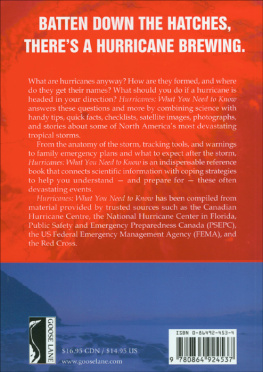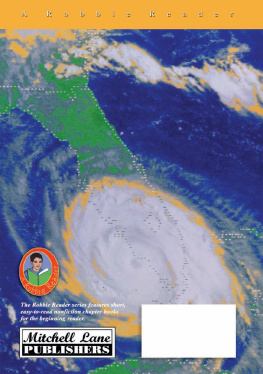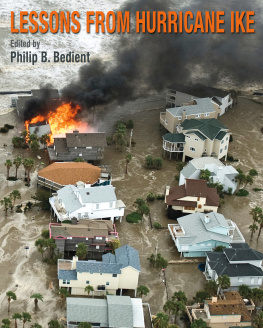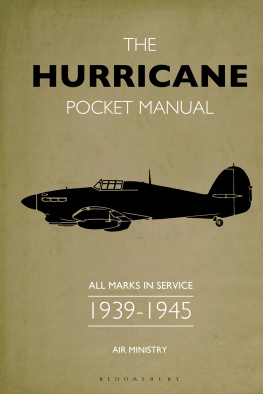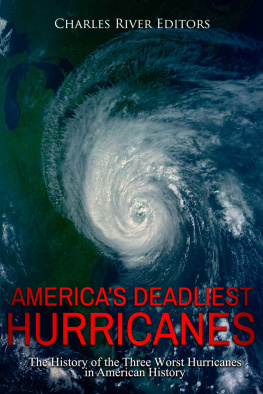Hurricanes: What You Need to Know
HURRICANES
WHAT YOU NEED TO KNOW
Copyright Goose Lane Editions, 2006.
All rights reserved. No part of this work may be reproduced or used in any form or by any means, electronic or mechanical, including photocopying, recording, or any retrieval system, without the prior written permission of the publisher or a licence from the Canadian Copyright Licensing Agency (Access Copyright). To contact Access Copyright, visit www.accesscopyright.ca or call 1-800-893-5777.
Cover illustration by Corbis.
Cover and interior design by Lisa Rousseau.
Compiled and edited by Rebecca Leaman.
Printed in Canada.
10 9 8 7 6 5 4 3 2 1
Library and Archives Canada Cataloguing in Publication
Hurricanes: what you need to know.
Includes bibliographical references and index.
ISBN 0-86492-453-4
1. Hurricanes. 2. Survival skills.
QC944.H87 2006 363.34922 C2006-900415-3
Published with the financial support of the Canada Council for the Arts, the Government of Canada through the Book Publishing Industry Development Program, and the New Brunswick Culture and Sports Secretariat.
Goose Lane Editions
500 Beaverbrook Court
Fredericton, New Brunswick
CANADA E3B 5X4
www.gooselane.com
WHAT IS A HURRICANE?
The Anatomy of a Storm
A tropical cyclone is an almost circular storm of extremely low pressure and high winds that spiral inward, accompanied by heavy rainfall. There are three types of tropical cyclones: tropical depressions, tropical storms, and hurricanes, which are the most intense and dangerous.
Hurricanes have three distinctive parts: the eye, the eye wall, and spiral rain bands.
The Eye
One of the most familiar parts of a tropical cyclone is the eye, produced by the intense spiraling of the storm. It is the region where the surface pressure is lowest and the temperature aloft is warmest, and the air in it is slowly sinking. The eye is the innermost zone of the tropical cyclone, but it is not always in the center of the storm. Sometimes it turns or moves in various directions with the storm itself, which continues to move forward on its own course.
The eye is surprisingly calm, with little or no wind. Within it, the skies are often clear, despite the fact that winds and clouds continue to rage around the edge of the eye. As the eye passes over a site, the sky clears and calm prevails. Then, the storm strikes again with high winds from the opposite direction.
The eye of a hurricane. U.S. Air Force
The Eye Wall
The eye of a tropical cyclone is surrounded by a ring of thunderstorms called the eye wall. The heaviest rain, strongest winds, and worst turbulence are normally in the eye wall. The mechanisms by which the eye and the eye wall are formed are not well understood, but it is generally thought that the feature is a fundamental component of all rotating fluids.
Spiral Rain Bands
Hurricanes are surrounded by bands of heavy convective showers that spiral inward toward the storms center. Cumulus and cumulonimbus (thunderstorm) clouds rise, and lightning develops in the spiral rain bands at the hurricanes edge.

Do not relax your precautions if a hurricane suddenly dies down. The eye may be passing directly over you. |
The upper eye wall of Hurricane Katrina, captured from a NOAA Hurricane Hunter aircraft over the Gulf of Mexico. The day before making landfall on August 28, 2005, Katrina was a strong Category 4 storm, and the eye was approximately 48 km (30 miles) in diameter. Note the spiral banding in the eye wall clouds and the clear sky above the eye. NOAA
The Life Cycle of a Hurricane
Origin
Many hurricanes that strike North America form in the tropical waters of the Atlantic Ocean or Caribbean Sea, move on a westerly to northerly track, steered by the prevailing wind direction, and strike the mainland on either the Gulf or Atlantic coast.
Hurricanes develop only in certain areas of the earth. Climatologists have defined seven regions of tropical storm formation: the western north Pacific, the eastern north Pacific, the Atlantic, the southwest Indian Ocean, the north Indian Ocean, and two areas off Australia: the southeast Indian Ocean and the southwest Pacific Ocean. The shape of the south Atlantic Ocean basin does not allow storm clouds from Africa enough time over warm water to develop into cyclones, and the waters of the eastern south Pacific are simply too cold for hurricane formation.
In order for tropical cyclones to form, several environmental conditions must be present:
The cyclone must originate over ocean water that is least 26.5C (80F). Hurricanes draw their energy from the warm water of the tropics and the latent heat of condensation.
The atmosphere must quickly become cooler as the altitude increases. This condition creates instability. If the air is unstable, the warm surface air will continue rising. If winds at all levels of the atmosphere are blowing at the same speed and from the same direction, the disturbance will grow.
Cyclones form no closer to the equator than approximately 500 kilometres (300 miles). This is because of the Coriolis Force, an effect caused by the turning of the earth, which starts the cyclone spiral and maintains the low pressure of the disturbance. Close to the equator, the Coriolis Force is too weak.
An upper atmosphere high-pressure area above the growing storm should be present. The air in such high-pressure areas flows outward, pushing away the air that is rising in the storm and drawing even more air up from the low levels.
The Growth of a Hurricane
A hurricane progresses through a series of stages from birth to dissipation. First, it begins as a tropical disturbance: a large area of organized thunderstorms that maintain their identity for more than 24 hours.
If the area of thunderstorms organizes so that a definite rotation develops and winds become strong, the system is upgraded to a tropical depression. At this point, a low-pressure center exists and the storm is given a number.
If winds continue to increase to 63 kilometres per hour (39 miles per hour, or 34 knots), the system becomes a tropical storm and is given a name. The system becomes more organized and the circulation around the center of the storm intensifies.
As surface pressures continue to drop, the storm becomes a hurricane when wind speed reaches 118 kilometres per hour (74 miles per hour, or 64 knots). An eye develops near the center of the storm, with spiral rain bands rotating around it.
Next page
